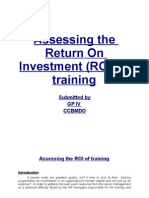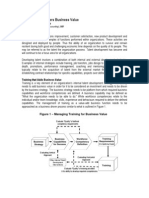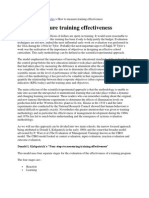Evaluation Strategies: The Purpose of Evaluation
Evaluation Strategies: The Purpose of Evaluation
Uploaded by
Sheeraz KhanCopyright:
Available Formats
Evaluation Strategies: The Purpose of Evaluation
Evaluation Strategies: The Purpose of Evaluation
Uploaded by
Sheeraz KhanOriginal Description:
Original Title
Copyright
Available Formats
Share this document
Did you find this document useful?
Is this content inappropriate?
Copyright:
Available Formats
Evaluation Strategies: The Purpose of Evaluation
Evaluation Strategies: The Purpose of Evaluation
Uploaded by
Sheeraz KhanCopyright:
Available Formats
Evaluation Strategies
In the current climate of cost cutting and downsizing, training professionals are under increasing pressure to provide positive, measurable evidence of the bottom line contribution of training. Yet evaluating the effects and results of training is notoriously difficult. Here are a few thoughts on evaluation, collected from our own experiences, which you may find useful in planning what to evaluate, and how to go about doing it. The purpose of evaluation It can be argued that the only training which organizations should be providing is training which contributes in some tangible way to both performance improvement and the achievement of business needs and objectives. Organizations which are working towards the Investors in People (IIP) initiative will be aware that evaluation is one requirement against which their training performance is tested as part of the recognition process: IIP Indicator 4.1: "The organization evaluates the impact of training and development on knowledge, skills and attitude." IIP Indicator 4.2: "The organization evaluates the impact of training and development actions on performance." IIP Indicator 4.3: The organization evaluates the contribution of training and development to the achievement of its goals and targets." The whole concept of Investors in People revolves around the idea that an organization which invests sensibly in developing its human resource will be better able to compete, and to meet its objectives effectively. Expenditure on training, therefore, is an investment for the future - and like any investment, it needs to be able to show a demonstrable return. If training is to be perceived as a worthwhile investment there must be: a direct correlation between training activity and performance improvement where possible, a financial value or benefit to the organization of having delivered the training.
Evaluation is concerned with collecting and presenting appropriate information in order to prove the relationship between training activity and benefits to the business. Evaluation is the process by which training professionals can collect, analyse and present the information needed in order to prove the business value of any training which has been delivered within their organization. Planning evaluation A common mistake which many organizations make is that they leave evaluation considerations until after they have planned and delivered their training. For evaluation to be truly effective the evaluation strategy needs to be planned and designed in conjunction with, rather than after the training planning and design stages.
Key questions to ask include the following:
1. What are the objectives of the training planned? 2. What benefit, effect or change will result from the achievement of these objectives? 3. How will these benefits, effects or changes contribute to the performance and/or needs of the
organization as a whole?
4. How will the actual benefits, effects or changes be identified and measured?
Answers to Question 1 will inform the content and design of the training itself. Answers to Questions 2 and 3 will link the training to identified business needs and objectives. Answers to Question 4 will inform the design of the evaluation strategy, and the evaluation methods to be used. Levels of evaluation Training can impact on the organization at various levels. One of the first steps which training professionals will need to go through when planning their evaluation strategy, is to decide what they will be measuring at each level, when they will be measuring it, and how it will be measured. Although it has been around for nearly 20 years, the Kirkpatrick Model (1979) is still the model most widely used to determine and plan different levels of evaluation:
Whilst the Kirkpatrick Model is useful as it stands, it can be further enhanced by the addition of a Level 0 and a Level 5. Level 1 (Reactions) is concerned with the measurement of peoples immediate attitudes to the training provided: Was it useful and relevant? Did they feel comfortable with it? Did it cover what was planned?
Happy sheets, feedback during the training and assessments by the trainer of the materials used are most commonly used at this level. Level 2 (Learning) is concerned with measuring the learning achieved as a result of the training:
What can participants do, that they could not do previously? What do participants know, that they did not know previously? What perception or understanding have participants gained, that they did not have previously?
Questionnaires, quizzes, and practical tests to check for any change in knowledge, skill or attitude are useful at this level. Level 3 (Behaviour) is concerned with measuring how actual workplace performance has changed as a result of the training: To what extent has learning been transferred to workplace performance? To what extent has workplace performance improved as a result of learning?
Evaluation at this level usually requires the involvement of Line Managers in setting post-training assignments which require and test newly acquired learning, or in observing and giving feedback about changes in day-to-day workplace performance. Level 4 (Results) is concerned with measuring the extent to which changes in performance have contributed to improved business results of the more effective achievement of business objectives. Measurement at this level needs to focus back to the identified contribution which the training would make to the performance and/or needs of the organization as a whole. If, for example, one of the reasons for the training was to assist the organization in its need to reduce production costs, then the measurement would need to involve some comparison of pre- and post-training production costs. As with Level 3 there would need to be some involvement from those outside the training function, in putting together and providing the required figures for comparison. Level 0 (Pre-training performance) is important, since it provides the initial benchmark against which training effectiveness can be measured. Pre-training knowledge, skill and attitude checks are invaluable in providing a point for comparison with Level 2 and Level 3 evaluation data. Level 5 (Return on investment) is also important, since it provides a financial value to the organization, of having delivered the training, i.e., a cost benefit ratio: financial value of change or effect achieved cost of achieving it x 100/1 = % return on investment. Rationalizing evaluation It is important not to get carried away with an evaluation effort which is disproportionately greater than the investment made, or the benefit likely to be achieved. The IPD study Making Training Pay (1997) suggests that the scope of an evaluation strategy should be carefully weighed against the following considerations: the size of the training investment the number of staff involved the likelihood that the training will be repeated the criticality of the training to the business the newness of the training methods used.
Training which is critical, uses unproven methods, will be repeated in a roll-out to all staff, and which has been costly to produce, obviously merits a far more extensive evaluation effort than, for example, a oneoff course delivered to a small, select group.
You might also like
- Sample BueptDocument29 pagesSample BueptÖzkan E.No ratings yet
- Cost Benefit Analysis in T & DDocument18 pagesCost Benefit Analysis in T & DDarshan Patil100% (5)
- Process Costing SystemDocument16 pagesProcess Costing SystemSheeraz Khan75% (4)
- Introduction To The Kirkpatrick New World ModelDocument16 pagesIntroduction To The Kirkpatrick New World Modelaziznawawi100% (1)
- Atmospheres of SeductionDocument13 pagesAtmospheres of SeductionAjaNo ratings yet
- English: Quarter 3 - Module 3: Compose An Independent Critique of A Chosen SelectionDocument24 pagesEnglish: Quarter 3 - Module 3: Compose An Independent Critique of A Chosen SelectionAzhty Mae Alquino Recla69% (13)
- Intro To "Body 2 Body: A Malaysian Queer Anthology"Document7 pagesIntro To "Body 2 Body: A Malaysian Queer Anthology"Amir MuhammadNo ratings yet
- WWW AihrDocument1 pageWWW Aihrnishumoni1610No ratings yet
- Training & Learning Metrics - How To Evaluate Training Program (2023)Document22 pagesTraining & Learning Metrics - How To Evaluate Training Program (2023)anantbhaskar100% (1)
- Response Sheets, ISTD Diploma of Training and DevelopmentDocument32 pagesResponse Sheets, ISTD Diploma of Training and Developmentsmita75100% (9)
- Definition of TrainingDocument18 pagesDefinition of TrainingTyagi Munda AnkushNo ratings yet
- Get The Right Feedback After TrainingDocument5 pagesGet The Right Feedback After TrainingB V Krishna MohanNo ratings yet
- Employee Training and DevelopmentDocument9 pagesEmployee Training and Developmentnelly ezraNo ratings yet
- Assessing The ROI of TrainingDocument10 pagesAssessing The ROI of TraininggollasrinivasNo ratings yet
- R of LDocument33 pagesR of LRaja SekharNo ratings yet
- The Kirkpatrick Phillips Evaluation Model of TrainingDocument12 pagesThe Kirkpatrick Phillips Evaluation Model of TrainingArakanshu SinghNo ratings yet
- Training EvaluationDocument30 pagesTraining Evaluationdmrpanda9940No ratings yet
- 4 Levels of Training KPIsDocument8 pages4 Levels of Training KPIsSonal ChaturvediNo ratings yet
- Training Value QuestionnaireDocument10 pagesTraining Value QuestionnaireBurhan Nawaz ButtNo ratings yet
- Answer of Some HRM ActivitiesDocument6 pagesAnswer of Some HRM ActivitiesAl AminNo ratings yet
- Handout 11Document2 pagesHandout 11Nicole Mae lapinzasNo ratings yet
- Challenge, Learning Seen As A Cost Without A Defined BenefitDocument10 pagesChallenge, Learning Seen As A Cost Without A Defined BenefitNurtantio QuidarNo ratings yet
- Table: Four Levels Evaluate Training Effectiveness Level Issue To Consider Tools For Testing 1 2Document3 pagesTable: Four Levels Evaluate Training Effectiveness Level Issue To Consider Tools For Testing 1 2Xuân HoàngNo ratings yet
- Unit IIIDocument13 pagesUnit IIImanjarisingh2502No ratings yet
- Assessing The ROI of TrainingDocument11 pagesAssessing The ROI of TrainingPraveen KeskarNo ratings yet
- Strategic/ Systematic Approach To Training For Human Resource DevelopmentDocument18 pagesStrategic/ Systematic Approach To Training For Human Resource DevelopmentSapna RaiNo ratings yet
- How To Measure Competency-Based Training - Elearning IndustryDocument6 pagesHow To Measure Competency-Based Training - Elearning IndustryToto SubagyoNo ratings yet
- Training 2 148Document7 pagesTraining 2 148CarmenLarisaNo ratings yet
- HRM 2Document20 pagesHRM 2binoy666No ratings yet
- Traning ReferneceDocument5 pagesTraning ReferneceSomzworld SomzNo ratings yet
- Measuring Training Effectiveness and Contributions To Organizational SuccessDocument39 pagesMeasuring Training Effectiveness and Contributions To Organizational SuccessAhmed YinkaNo ratings yet
- Article On TrainingDocument3 pagesArticle On TrainingShaikh AyeshaNo ratings yet
- What Is A Training Needs Analysis?Document6 pagesWhat Is A Training Needs Analysis?bonyNo ratings yet
- How To Measure Training Effectiveness: Home Our News and ArticlesDocument7 pagesHow To Measure Training Effectiveness: Home Our News and Articlesanon_175099681No ratings yet
- Effectiveness Evaluation of Behavioural Training and Development ProgrammesDocument9 pagesEffectiveness Evaluation of Behavioural Training and Development Programmesthesij100% (1)
- Handout 1. Designing The Training ProgramDocument4 pagesHandout 1. Designing The Training ProgramZooey100% (1)
- Off-The-Job Training: in House ProgrammesDocument8 pagesOff-The-Job Training: in House ProgrammesUpadhayayAnkurNo ratings yet
- 5 Steps To Creating Effective Training ProgramsDocument7 pages5 Steps To Creating Effective Training ProgramsRembrandth Vermeer De GuzmanNo ratings yet
- Measuring Training Effectiveness: A Practical Guide - AIHRDocument15 pagesMeasuring Training Effectiveness: A Practical Guide - AIHRAndrea Miranda EcheverriaNo ratings yet
- Measuring the Return on Investment of Internal and External TrainingDocument5 pagesMeasuring the Return on Investment of Internal and External TrainingYASSERNo ratings yet
- Learning TransferDocument3 pagesLearning Transferpstrupp3347No ratings yet
- Evaluation ModelDocument7 pagesEvaluation ModelHumaizah MaiNo ratings yet
- Evaluation of Training Programmes: BackgroundDocument7 pagesEvaluation of Training Programmes: BackgroundUpadhayayAnkurNo ratings yet
- Assignment in Industrial Psychology: Submitted By: Norma E. Agustin Llb-Mba IiDocument3 pagesAssignment in Industrial Psychology: Submitted By: Norma E. Agustin Llb-Mba IiUmma Eugenio AgustinNo ratings yet
- Training & Development in OrganizationsDocument50 pagesTraining & Development in OrganizationsVaness Grace AnibanNo ratings yet
- RAVI Project ON TNIDocument13 pagesRAVI Project ON TNIuraviabvpNo ratings yet
- ORG MGT QTR2 Mod3 The Importance of Compensation and WagesDocument8 pagesORG MGT QTR2 Mod3 The Importance of Compensation and WagesolajerammilNo ratings yet
- HRD 4 CH 7Document28 pagesHRD 4 CH 7AlphaNo ratings yet
- Training Need IdentificationDocument11 pagesTraining Need IdentificationSukhdev Sharma100% (1)
- Assignment 1-Training & DevelopmentDocument3 pagesAssignment 1-Training & DevelopmentNadira KhanNo ratings yet
- An Introduction To The New World Kirkpatrick Model A White PaperDocument16 pagesAn Introduction To The New World Kirkpatrick Model A White PaperLucrecia Mendes da SilvaNo ratings yet
- Training and Executive DevelopmentDocument22 pagesTraining and Executive DevelopmentEldeen EscuadroNo ratings yet
- An Analysis of Various Training Evaluation ModelsDocument9 pagesAn Analysis of Various Training Evaluation ModelsRajeshNo ratings yet
- An Analysis of Various Training Evaluation ModelsDocument9 pagesAn Analysis of Various Training Evaluation ModelsRanaa hannaNo ratings yet
- Steps in Training Needs Assessment (TNA)Document14 pagesSteps in Training Needs Assessment (TNA)Samuel Uwa100% (1)
- Ch. 5. HRMDocument13 pagesCh. 5. HRMneway gobachewNo ratings yet
- Detailed Guidelines To Students On Internship Istd ProjectDocument4 pagesDetailed Guidelines To Students On Internship Istd ProjectRavishankar ThangarajaNo ratings yet
- Anglais Economique Cooriger - 103017Document9 pagesAnglais Economique Cooriger - 103017david kitwanaNo ratings yet
- Training and DevelopemntDocument17 pagesTraining and DevelopemntANKIT SINGH RAWATNo ratings yet
- How To Conduct A Training Needs AnalysisDocument6 pagesHow To Conduct A Training Needs AnalysisShahzad Salim100% (1)
- Tranfer of LearningDocument2 pagesTranfer of LearningDragan RistovskiNo ratings yet
- Teori PenelitianDocument11 pagesTeori PenelitianSeller MilenialNo ratings yet
- HRM - Evaluation of TrainingDocument5 pagesHRM - Evaluation of TrainingrohanNo ratings yet
- How to Improve Performance through the Balanced ScorecardFrom EverandHow to Improve Performance through the Balanced ScorecardRating: 3 out of 5 stars3/5 (3)
- 5th ClasspaperDocument2 pages5th ClasspaperSheeraz KhanNo ratings yet
- Independent Contractor Agreement For Construction ContractorDocument8 pagesIndependent Contractor Agreement For Construction ContractorSheeraz KhanNo ratings yet
- Length Wedth Result Length Wedth Result: S.No S.NoDocument2 pagesLength Wedth Result Length Wedth Result: S.No S.NoSheeraz KhanNo ratings yet
- Imran CalculationDocument1 pageImran CalculationSheeraz KhanNo ratings yet
- Construction Quote: Prepared by (Company Address) (Company Phone) For (Client Company Address) (Client Company Phone)Document3 pagesConstruction Quote: Prepared by (Company Address) (Company Phone) For (Client Company Address) (Client Company Phone)Sheeraz Khan100% (1)
- Psychology Notes Class 11thDocument2 pagesPsychology Notes Class 11thSheeraz KhanNo ratings yet
- Straining Post Intermediate Post 2.5 Meter Length Between PostsDocument1 pageStraining Post Intermediate Post 2.5 Meter Length Between PostsSheeraz KhanNo ratings yet
- Traditional Weddings in Great Britain: Created by Val Jones With Acknowledgements To ScranDocument7 pagesTraditional Weddings in Great Britain: Created by Val Jones With Acknowledgements To ScranSheeraz KhanNo ratings yet
- Highly Commended Petya Koleva BMRIDocument1 pageHighly Commended Petya Koleva BMRISheeraz KhanNo ratings yet
- Dear Sir/Madam: Application For The Position ofDocument1 pageDear Sir/Madam: Application For The Position ofSheeraz KhanNo ratings yet
- Discretionary AccrualDocument2 pagesDiscretionary AccrualSheeraz Khan100% (1)
- Southwest BriefDocument2 pagesSouthwest BriefSheeraz KhanNo ratings yet
- QuestionerDocument2 pagesQuestionerSheeraz KhanNo ratings yet
- Job Opportunity: Position: DRIVER LocationDocument2 pagesJob Opportunity: Position: DRIVER LocationSheeraz KhanNo ratings yet
- Writing Qualitative Research QuestionsDocument3 pagesWriting Qualitative Research QuestionsNeha NaliniNo ratings yet
- Philosophy of Science and Research MethodologyDocument4 pagesPhilosophy of Science and Research MethodologyFadhel Banna PalitaNo ratings yet
- Bob Ostertag - Creative LifeDocument222 pagesBob Ostertag - Creative LifeJoseph AnthonyNo ratings yet
- Hindu Girl Baby NamesDocument2 pagesHindu Girl Baby NamesYovi SharmaNo ratings yet
- Design and Technology PortfolioDocument15 pagesDesign and Technology Portfolioapi-251699280No ratings yet
- 3 Akhyata-PrakaranaDocument487 pages3 Akhyata-PrakaranaGonzaloNo ratings yet
- Trait: Strengths/Advantages of Trait TheoryDocument3 pagesTrait: Strengths/Advantages of Trait TheoryDaniya RaheelNo ratings yet
- Vrindavan Forest ScriptDocument1 pageVrindavan Forest ScriptMadhu Madhav DasNo ratings yet
- Guidelines For Defining Affective Domain Course Learning OutcomesDocument4 pagesGuidelines For Defining Affective Domain Course Learning Outcomesomer1299No ratings yet
- Alchemy To Toxicology: Steven G. Gilbert, PHD, Dabt Institute of Neurotoxicology & Neurological DisordersDocument24 pagesAlchemy To Toxicology: Steven G. Gilbert, PHD, Dabt Institute of Neurotoxicology & Neurological DisordersVineet NavrangNo ratings yet
- Simple Structures in Musica RicercataDocument122 pagesSimple Structures in Musica RicercataMartin Pol100% (2)
- Reader Report Session 3 - John Caldwell - Excessive TelevisionDocument3 pagesReader Report Session 3 - John Caldwell - Excessive TelevisionVeerla84No ratings yet
- Criticism On Psychoanalysis of FreudDocument6 pagesCriticism On Psychoanalysis of FreudHassanJanNo ratings yet
- Slide04 NumSys Ops Part2Document25 pagesSlide04 NumSys Ops Part2อภิเษก หงษ์วิทยากรNo ratings yet
- 05 The Complexity of Identity Beverly TatumDocument6 pages05 The Complexity of Identity Beverly Tatumpoetliane100% (1)
- Culture Lecture 2Document36 pagesCulture Lecture 2TIED PK100% (1)
- ME101 Lecture29 KDDocument16 pagesME101 Lecture29 KDSiddharthaNo ratings yet
- Lupane State University Masters Dissertation GuideDocument19 pagesLupane State University Masters Dissertation GuideCharity MatibaNo ratings yet
- Essential Tips For Well Control Success: Aberdeen Drilling SchoolsDocument4 pagesEssential Tips For Well Control Success: Aberdeen Drilling SchoolsCerón Niño SantiagoNo ratings yet
- Systematic InvestigationDocument2 pagesSystematic InvestigationDan Lorenz OlbesNo ratings yet
- When Solutions of Yesterday Become Problems of Today PDFDocument12 pagesWhen Solutions of Yesterday Become Problems of Today PDFWenna Grace OdtujanNo ratings yet
- Relative SetDocument247 pagesRelative Setsean gNo ratings yet
- Amazon Interview Preparation GuideDocument2 pagesAmazon Interview Preparation GuideagNo ratings yet
- 7 CsDocument8 pages7 CsRizwan ZamanNo ratings yet
- Induction Motor Control by Vector Control Method.: Miss. Bhagyashree Thool, Miss. Kalyani C. WakhareDocument6 pagesInduction Motor Control by Vector Control Method.: Miss. Bhagyashree Thool, Miss. Kalyani C. WakhareASumeethKumarNo ratings yet
- Capitulo 9 de Las AuditoriasDocument2 pagesCapitulo 9 de Las Auditoriascolumna74No ratings yet








































































































